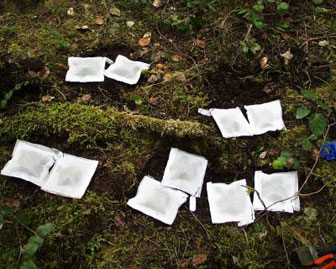Leaf study could produce better global warming models
Leaf study could produce better global warming models
Rhett A. Butler, mongabay.com
January 18, 2007
A new study on rotting leaves could produce more accurate climate models say researchers writing in the January 19 issue of the journal Science
The Long-Term Inter-site Decomposition Experiment, involving 21 field sites from seven biomes from tundra to tropical rainforests, found that the processes of leaf decomposition and nitrogen release are relatively simple. The dominant drivers of nitrogen release were the initial concentration of nitrogen and the remaining mass of the leaf and root litter, while the rate of decomposition was influenced by temperature and moisture. The fastest rates of decomposition occurred in tropical rainforests where nutrients are rapidly cycled.

Leaf litter falls to the ground where it is decomposed by microbes. As it decays it releases nitrogen, a key nutrient for plants and animals. Photo by William S. Currie |
“In the world of complex biogeochemistry, we’ve discovered that this fundamental process of nutrient cycling by plants and microbes turns out to be relatively straightforward,” said Whendee Silver, professor of ecosystem sciences at UC Berkeley and co-lead author of the study. “Whether it’s hot or cold, wet or dry, the equations work. This study highlights the fact that, for microbes, there is a fundamental physiological constraint controlling nitrogen release during decomposition. It took a large-scale, long term study like this to help us see how simple these processes can be.”
“The most important component of this study is that we’ve developed a generic global law that can predict large-scale patterns in litter mass decay rates and nitrogen release from litter,” said William Parton, senior research scientist at the Natural Resource Ecology Laboratory at Colorado State University and co-lead author of the study. “There are a lot of global nutrient cycling models out there, but the model we’ve developed is based on only two parameters, and thus is more scientifically elegant and more widely applicable than the models currently being used.”
The researchers say that their work will help climatologists better forecast climate change by helping them better predict the amount of carbon released into the atmosphere from decomposing forest litter.

Leaf and root litter were placed in mesh bags on the ground and left for up to 10 years. Subsets of bags were collected every year to determine the rate at which the leaves and roots decayed. The nitrogen content of the litter was also measured.. Photo by Jay M. Sexton |
“As people try to construct computer models and predict future climate changes, being able to accurately predict carbon and nitrogen cycling will play a key role,” said Silver.
“The debate is whether the enhanced litter decay rate from warming will also increase the release of carbon from ecosystems,” added Parton. “When you increase litter decomposition rates, you are enhancing carbon dioxide release to the atmosphere. Our study provides algorithms to better predict the rates of these processes under a wide range of conditions.”
This article is based on a news release from Colorado State University and the University of California-Berkeley.







